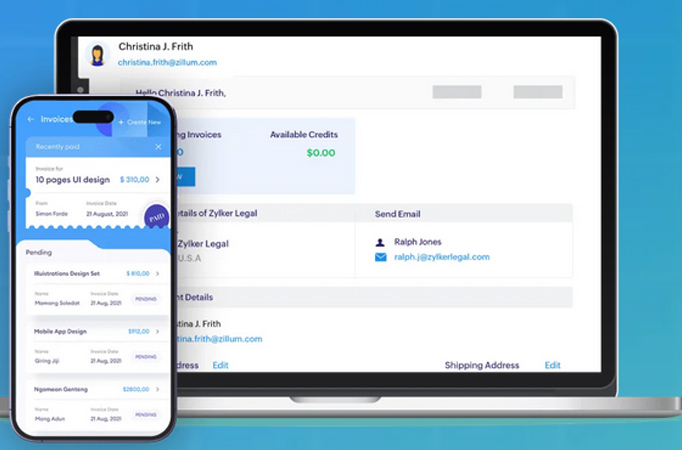
Invoicing is an essential part of doing business. Whether you’re a freelancer, small business owner, or part of a larger company, having a professional invoice can help ensure that you get paid promptly and maintain a professional image. Thankfully, with the rise of online tools, creating professional invoices has never been easier.
Invoice generators offer simple and efficient ways to produce well-designed, accurate invoices that reflect your brand. In this article, we’ll explore how to create professional invoices using an invoice generator and provide tips to make sure your invoices stand out.
See more: https://www.zintego.com
1. Why Use an Invoice Generator?
Before diving into the specifics of creating invoices, it’s worth understanding why an invoice generator is such a valuable tool. Traditionally, invoices were often created manually, either through paper forms or using spreadsheet software. This method could be time-consuming, prone to errors, and lacked professionalism.
An invoice generator, on the other hand, streamlines the entire process. It provides pre-designed templates, automates calculations (like tax and totals), and can even send invoices directly to clients. The benefits of using an invoice generator include:
- Time-saving: Automates calculations and reduces the need for manual data entry.
- Customization: Allows you to add your company logo, adjust layouts, and tailor invoices to fit your business needs.
Consistency: Ensures all your invoices look the same, improving your brand’s consistency and professionalism.
Accuracy: Minimizes the risk of mistakes like incorrect totals, taxes, or billing details.
Now that we understand the value of an invoice generator, let’s break down the steps to creating a professional invoice.
See more: https://www.vantazo.com
2. Choose the Right Invoice Generator
The first step in creating professional invoices is selecting an invoice generator that suits your business needs. There are plenty of options available, from free, simple tools to advanced, paid solutions. Some popular invoice generators include:
- FreshBooks
Zoho Invoice
Invoice Ninja
Wave
QuickBooks Invoice Generator
When choosing a generator, consider the following:
- Ease of use: Does it have a user-friendly interface?
- Customization options: Can you add your logo, change fonts, and adjust colors to match your brand?
Integration: Does the generator integrate with accounting tools or payment gateways like PayPal or Stripe?
Pricing: Is it affordable based on the size and needs of your business?
3. Enter Your Business Information
Once you’ve chosen your invoice generator, it’s time to enter your business information. This will typically include:
- Business name: Include your full business name (and any registered DBA name if applicable).
Logo: Upload your company logo to help personalize and professionalize the invoice.
Contact information: This should include your business address, phone number, email, and website.
Tax information: If applicable, include your tax ID number or VAT registration, which is particularly important for international transactions.
By entering this information into the invoice generator once, you’ll be able to generate invoices much faster moving forward.
See more: https://www.luzenta.com
4. Add Client Information
Next, input your client’s details, including:
- Client’s business name: Be sure to spell this correctly.
Client’s contact info: This can include the client’s address, phone number, and email.
Billing address: If your client’s billing address differs from their contact address, make sure to include that too.
Some invoice generators allow you to save this information, so you can quickly select the client for future invoices.
See more: https://www.evontos.com
5. Customize the Invoice Template
The beauty of using an invoice generator is that it allows you to create a tailored, professional-looking document without needing any design skills. You can adjust:
Layout: Choose from various templates that fit your business’s aesthetic. Some generators offer templates
specifically for freelancers, while others are more suited for product-based businesses.
Color scheme: Match the color scheme to your branding for a cohesive look.
Font style and size: Make sure the text is easy to read and consistent with your brand.
Logo placement: Ensure your logo is prominently displayed at the top of the invoice to reinforce your brand’s presence.
6. List Products/Services and Set Prices
Now, it’s time to detail what the invoice is for. Be clear and precise with the items you list. Most invoice generators allow you to break down your products or services into different line items, so you can list the:
- Description: Provide a brief, clear description of the product or service rendered.
Quantity: If applicable, list the number of items or hours worked.
Rate/Price: Include the unit price for each item or the hourly rate for services rendered.
Total: The invoice generator will typically calculate the subtotal and total automatically based on your input.
It’s essential to be transparent here—this helps prevent confusion and ensures that clients understand exactly what they’re paying for.
See more: https://www.trevozo.com
7. Add Taxes, Discounts, and Additional Fees
In some regions, businesses are required to include tax information. Most invoice generators have built-in features to calculate the correct sales tax based on your location and your client’s location. You can also add any discounts or special offers here to further personalize the invoice.
If you charge for shipping, handling, or any other additional fees, ensure these are listed clearly on the invoice. Transparency helps avoid any surprises for your clients.
8. Set Payment Terms and Due Date
Every invoice should include clear payment terms. You’ll need to specify:
Payment due date: Include a clear due date to help avoid late payments. Common due dates are "Due upon receipt," "Net 30," or "Due in 14 days."
Accepted payment methods: Indicate which payment methods you accept (bank transfer, credit card, PayPal, etc.).
Late payment fees: If applicable, outline any late fees or penalties that will be applied to overdue invoices.
9. Review and Send the Invoice
Once you’ve completed the invoice, review it for any errors or omissions. Double-check the numbers and make sure all client details are accurate. Most invoice generators offer a preview feature so you can see exactly how your invoice will appear when sent to the client.
After reviewing, hit "send"—and depending on the invoice generator, you may be able to send it directly via email. Some generators even allow you to track whether your client has viewed the invoice.
See more: https://www.entovo.com
10. Keep Records for Your Accounting
Finally, once the invoice is sent, make sure to keep a record for your accounting purposes. Many invoice generators automatically store your invoices in a cloud-based system, so you can access them anytime. Having organized records will simplify your accounting and make tax season a breeze.
Conclusion
Creating professional invoices is essential for building trust with clients and ensuring smooth cash flow for your business. With an invoice generator, you can automate the process, save time, and produce invoices that reflect the professionalism of your business. By customizing your templates, entering accurate details, and setting clear payment terms, you’ll have invoices that not only look great but also ensure timely payments. Start using an invoice generator today and streamline your invoicing process for greater efficiency and professionalism!










Add new comment